Rebar Rope & Rigging FAQ
for desert structures and camping
Also see: Desert Structures
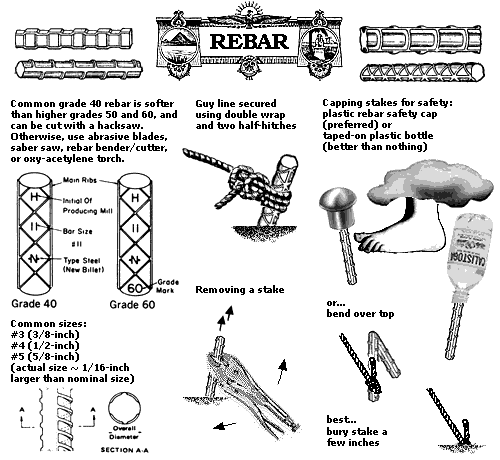
Q. So what's this "rebar" stuff?
A. "Rebar" is the steel reinforcing bar used in concrete construction. The term dates from the post-war American building boom of the 1950s, although reinforcing steel has been in use since the 1920s. Ridges are rolled into it as it's milled, to mechanically anchor it in concrete. Rebar is dark gray when new, rusty orange and scaly when exposed to the weather.
The most common sizes are #3 (3/8-inch), #4 (1/2-inch), and #5 (5/8-inch). The overall diameter is about 1/16-inch larger than the nominal size, because the ribs and deformations project slightly. Half-inch rebar might fit a half-inch hole in thin material, but it might be a very tight fit. Grade 40 rebar is the most common for homes and landscaping; Grades 50 and 60 are harder and stronger. Rebar is usually sold in 20-foot lengths, but shorter lengths are available, or can be cut at the store.
Q. Zzzzz.... so what's rebar got to do with Burning Man?
A. Finding and using junk instead of buying new stuff, and discovering unintended uses for cheap conventional stuff, is a way of life for many of us. People use lengths of rebar for tent stakes and anchor pins for other structures. And for constructing the frame or armature for large sculptures, such as the clay-coated figures and towers made for the Burning Man Opera. Rebar is often cast aside in trash piles or dumpsters on construction sites, but it's available at metal suppliers, lumber yards, and hardware stores. It's often cheaper than buying new tent stakes or other materials. Use a pair of gloves when dumpster-diving or shopping for rebar.
Q. Okay... we have a project we're working on. Home Crackpot has pieces of 3/8-inch rebar, 12 inches long. Is this good enough for guying off a 40-foot-tall wooden effigy?
A. No. They'll jump out of the ground like a ground squirrel on fire.
Let's back up a little. You have a project, or just a tent or awning you want to keep from blowing away when you set it up in the desert. You've heard that rebar is a good thing to use for stakes.
Rebar is cheap, but isn't the only, or best, stake material available.
Q. So what size stake should I use?
A. We can only suggest what we've seen work in the past. You must decide yourself, and take responsibility for your own structures. For larger structures, we suggest looking at other materials for stakes and anchors. These might include steel fence posts, car axle shafts, plumbing pipe, form stakes, or screw-in ground anchors. Wood stakes, aluminum stakes, sandbags, big rocks, water barrels, and other materials can be used for anchoring small structures where appropriate. Steel tee-stake fenceposts, or long large-diameter stakes, work well for helping support the posts of a shade structure or the base of a scaffold.
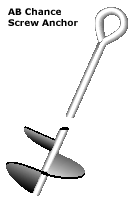 I work with Burning Man building shade structures and other things. The most common stakes we use are 24- to 48-inch-long, 3/4-inch-diameter steel form stakes used to hold up concrete forms. Form stakes are available at the same lumber yards where you would find rebar. I use these much more often than rebar.
I work with Burning Man building shade structures and other things. The most common stakes we use are 24- to 48-inch-long, 3/4-inch-diameter steel form stakes used to hold up concrete forms. Form stakes are available at the same lumber yards where you would find rebar. I use these much more often than rebar.
The screw-in ground anchors we use for radio towers and the guylines for the Burning Man are at least 40 inches long, with a 4-inch-diameter screw. The largest are 60 inches long, with a 6-inch-diameter screw. These can be started by digging a small hole, and turned in using a pipe or heavy bar.
Two stakes driven crosswise at one anchor point give extra holding power. Stakes can be grouped by putting them in line, at least a foot apart, and wiring them together.
The Desert Structures page has more info on materials and sources. Skip down on this page to see a few knots.
Typical stake sizes (general guide only; your needs may be different):
| Structure | Minimum Stake Length (in.) | Minimum Stake Size (in.) |
| Carpeting, astro-turf | 6 to 12 | 3/16 or heavier* |
| Small tent, structures up to about 8 ft tall | 12 to 24 | 3/8 or heavier |
| Medium tent, small dome, structures up to about 15 ft tall | 24 to 36 | 1/2 or heavier |
| Large tent or dome, structures up to about 25 ft tall | 36 to 48 | 5/8 or heavier |
| Structures greater than 25 ft tall | 36 to 48 | 3/4 or heavier | * 60D nails (spikes) are 1/4 in. x 6 in. |
Q. How do I cut rebar?
A. Use a metal-cutting blade in a circular saw; rebar cutters or bolt cutters (may be available at the hardware store); a hack saw; or a saber saw with coarse metal-cutting blades. Buy extra blades for whatever tool you use.
Grade 40 rebar is easy to cut with a saw. Grades 50 and 60 are much harder.
Q. How do I pound them in?
A. Use a 20-ounce or heavier carpenter's hammer, or a small sledge.
Q. Ouch! I just gashed my foot on that stake!
A. You just experienced a very common camping injury. I like to bury stakes a little below the surface whenever I can, by scratching a hole with the claw of a hammer, pounding in the stake, attaching the guy line, and covering with dirt.
Orange plastic safety covers are available at hardware stores, that fit over the top of the rebar. Or tape on a plastic bottle. Tennis balls work too. Tie bright things to your guy lines so people don't run into them at night.
Q. I've heard some people bend over the top of rebar stakes.
A. You can put the rebar in a vise, heat a spot a few inches below the top of the stake with a torch until it's glowing red, and bend it over with a hammer into a "J" or sharp "V" shape. A sharper bend at the top makes it easier to drive with a hammer.
A rebar cutter/bender, or construction tools such as Berkeley Bar Benders, can also be used to put a bend in the top. Or, plumbing pipe can be slipped over the ends, and bent together to make a sharp bend.
Q. Do I need to put a point on the end?
A. Couldn't hurt, but not really necessary. You could point the stake with a grinder, abrasive blade, or coarse file.
Q. How do I get it out of the ground?
A. Grip with a large pair of vise-grip pliers, or a plumbing wrench, and twist it back and forth or around as you pull upward. Wear gloves. Usually, it's not necessary to pour water in to loosen the stake, but some people do. Just makes the ground and the stake gooey. If you need to pull dozens of them, stake pullers are available from hardware stores. A farm jack and a chain works for almost anything. Or a chain and long steel bar, with a wood block for a fulcrum.
Q. I'm hooked on rebar. Where can I find out more?
A. Burning Man has its own Rebar 101 guide. Also check out the ARF and Civilized Explorer sites. The best way to learn is to observe what other people use, and ask how it's working out for them.
Enjoy your future in iron mongery.
A. Sure.
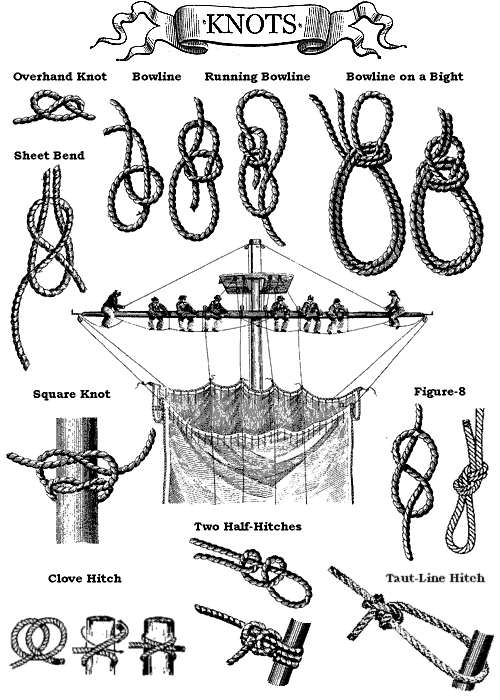
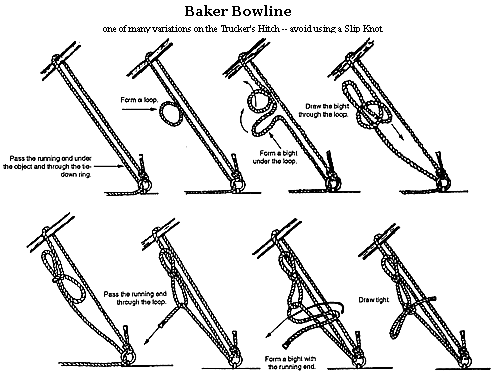
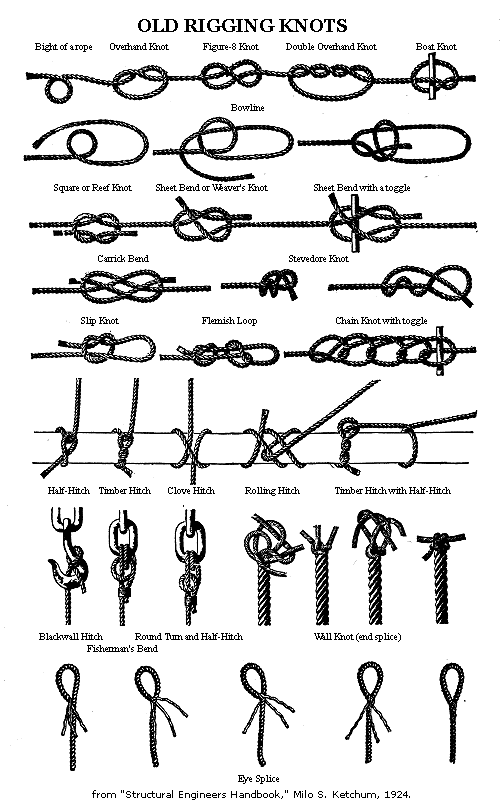
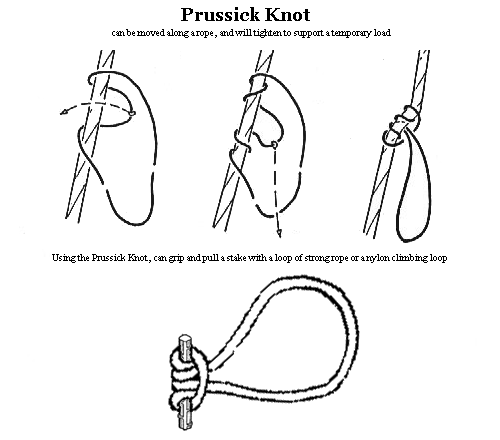
Shear, Tripod, and Square Lashings (start w/clove hitch on one pole, wrap at least four times around, then between poles):
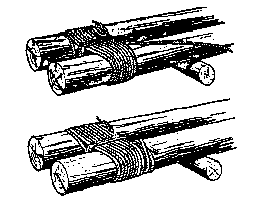
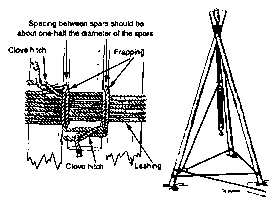
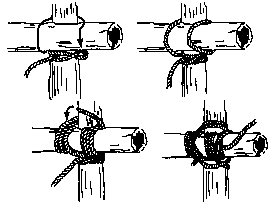
Multiple Stakes:
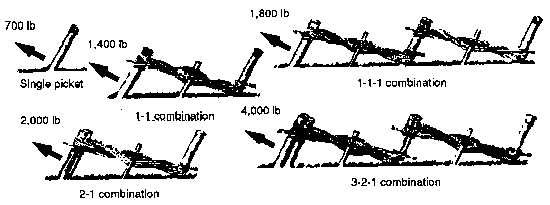
Q. How about wire rope (steel cable)?
A. For smaller structures, 3/16-inch wire rope might be fine; for larger structures, at least 1/4-inch. Note the working strength printed on the spool. Wire rope clips should be used in sets of three for loops and splices. Thimbles reduce stress on the wire rope, and allow easier attachment to a structure using a quick-link or shackle.
Never saddle a dead horse -- place the saddle part of the wire rope clips on the live part of the line.
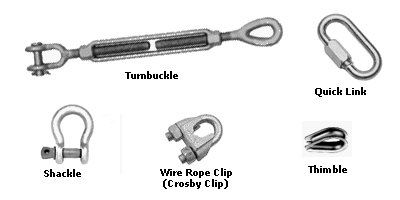
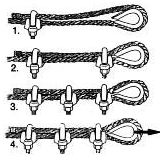
© Bob Stahl | Home